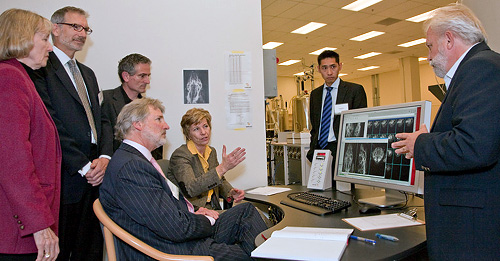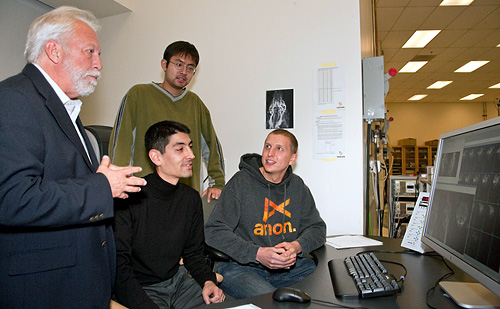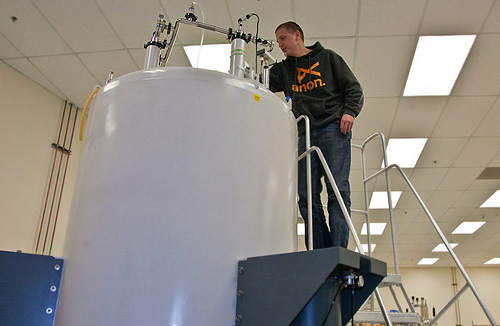Panel Calls for Continued Investment in UCSF's Research Programs

Prostate cancer expert John Kurhanewicz, right, explains some of the advanced imaging capabilities of the Nuclear Magnetic Resonance (NMR) Lab at Mission Bay to, clockwise from left, Graduate Division Dean Patricia Calarco; UCSF professor Sandy Johnson; biotech entrepreneur Corey Goodman; UCSF Chancellor Sue Desmond-Hellmann; San Francisco business development official Todd Rufo; and venture capitalist Steven Burrill.
A group of influential leaders from academia, industry and government gathered recently at UCSF to discuss the importance of keeping the University at the forefront of scientific innovation at a time of painful budget cuts and fee increases.
The event, “Focus on Research: Strategies for Accelerating Health Science Research,” was hosted by UCSF’s Graduate Division, which offers 20 health science degree programs and oversees the University’s 1,100 postdoctoral scholars.
“Nothing we do here has greater impact nationwide and worldwide than research,” said Graduate Division Dean Patricia Calarco, PhD, who moderated the panel discussion at the Mission Bay campus.
In fact, added panelist Alexander “Sandy” Johnson, PhD, graduate students are the often-unseen helping hand behind nearly all of the discoveries and innovations that have sprung from UCSF over the years.
“Students have actually changed the [research] direction of labs at UCSF,” said Johnson, professor and vice chair of the Department of Microbiology and Immunology and director of the Tetrad graduate program. “They inspire faculty members to push themselves.”
However, Johnson noted, UCSF’s highly esteemed graduate programs are “quite fragile financially.” This year for the first time, several major programs were forced to shrink the size of their incoming class of students.
Smaller classes are just one byproduct of the ongoing statewide fiscal crisis. The California Legislature has cut more than $800 million from the University of California’s budget over the last two years, prompting UC to pursue a path of increased tuition fees, reduced faculty and staff salaries and decreased course offerings.
UCSF Chancellor Sue Desmond-Hellmann, MD, MPH, has pledged to pursue new sources of revenue and advocate for the University at the state and national level to ensure that economic woes don’t hamper innovation and prevent the best and brightest from joining UCSF’s ranks. She plans to visit with state legislators in Sacramento in January.

John Kurhanewicz, left, director of the NMR Lab, discusses ongoing research with three lab alumni who currently work in the Department of Radiology: postdoc Simon Hu, rear; associate specialist Hikari Yoshihara, center; and postdoc Cornelius von Morze, right.
Desmond-Hellmann, who appeared at the Nov. 12 event, said that two of her five top priorities as chancellor—discovery and education—are “driven in no small part by our graduate programs, our postdocs.”
“What the world needs from UCSF is something transformative,” she said. “My job is making sure UCSF has the resources and talent it needs to fulfill its mission” of advancing health worldwide.™
As part of that effort, UCSF will collaborate with the nine other UC campuses on a newly launched fundraising effort. Project You Can, which was unveiled by UC President Mark Yudof on Oct. 23, aims to raise $1 billion for student support over the next four years. That sum would double the amount of private support the system has raised for scholarships, fellowships and other gift aid in the previous five years.
Benefits of Investing in Students
By attracting and retaining the strongest students and postdocs, UCSF will be able to meet industry demands for a steady stream of scientific breakthroughs that can be transformed into new drugs and treatments, said Bay Area biotech entrepreneur Corey Goodman, PhD, who participated in the Nov. 12 event.
The pharmaceutical industry “is great at phase-3 clinical trials, sales and marketing, but they’re not so good at innovation and discovery,” Goodman said. “That’s what UCSF is primed to give them: innovation and new technologies.”
UCSF’s appeal as a potential source of “the next big thing” in biotech is already evident in the number of new companies making their home in San Francisco, particularly in the area around the Mission Bay campus, said panelist Todd Rufo, director of business development for the city’s Office of Economic and Workforce Development.
“UCSF draws new companies to the area,” he said. “It provides a collaborative ecosystem that is unmatched anywhere.”
Another panelist, the life science venture capitalist Steven Burrill, pointed out that both sides stand to benefit from greater collaboration between academia and industry.

Postdoctoral researcher Cornelius von Morze peers into a 14-tesla nuclear magnetic resonance spectrometer, one of the high-powered diagnostic imaging tools at UCSF’s NMR Lab.
“Our challenge isn’t that we’re failing at discovery; it’s getting the discovery translated,” said Burrill, who teaches a popular course at UCSF, “Idea to IPO,” that aims to give students insight into the biotech industry, as well as the tools they need to create viable business plans and launch start-ups.
Lab Illustrates Groundbreaking Work
Before the Nov. 12 discussion began, Calarco and the five panelists visited UCSF’s state-of-the-art Nuclear Magnetic Resonance (NMR) Lab in Genentech Hall, where researchers use extremely advanced diagnostic imaging techniques to study the extent and aggressiveness of prostate cancer; the chemical changes associated with disc degeneration; the metabolic profiles of brain tumors; and other research areas.
NMR Lab director John Kurhanewicz, PhD, said he hoped the brief tour would give the panelists a sense of the kind of groundbreaking work that is taking place at UCSF thanks in large part to the University’s graduate students and postdocs.
“The driving force behind many of the studies going on in this lab is students from our graduate programs,” said Kurhanewicz, a professor of radiology and pharmaceutical chemistry who also heads UCSF’s Prostate Imaging Group. “Those programs are just amazing. Some of our graduate students are as good as any postdocs I could hire from outside the University.”
Photos by Susan Merrell
Related Links:
UC President Announces Twin Efforts to Increase Student Support [PDF]
UC Office of the President, Oct. 23, 2009